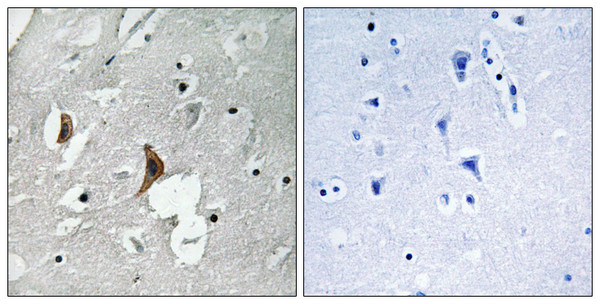| Post Translational Modifications | Phosphorylated on tyrosine residues. Phosphorylation at Ser-1303 by DAPK1 enhances synaptic NMDA receptor channel activity. |
| Function | Component of N-methyl-D-aspartate (NMDA) receptors (NMDARs) that function as heterotetrameric, ligand-gated cation channels with high calcium permeability and voltage-dependent block by Mg(2+). Participates in synaptic plasticity for learning and memory formation by contributing to the long-term depression (LTD) of hippocampus membrane currents. Channel activation requires binding of the neurotransmitter L-glutamate to the GluN2 subunit, glycine or D-serine binding to the GluN1 subunit, plus membrane depolarization to eliminate channel inhibition by Mg(2+). NMDARs mediate simultaneously the potasium efflux and the influx of calcium and sodium. Each GluN2 subunit confers differential attributes to channel properties, including activation, deactivation and desensitization kinetics, pH sensitivity, Ca2(+) permeability, and binding to allosteric modulators. In concert with DAPK1 at extrasynaptic sites, acts as a central mediator for stroke damage. Its phosphorylation at Ser-1303 by DAPK1 enhances synaptic NMDA receptor channel activity inducing injurious Ca2+ influx through them, resulting in an irreversible neuronal death. |
| Protein Name | Glutamate Receptor Ionotropic - Nmda 2bGlun2bGlutamate Nmda Receptor Subunit Epsilon-2N-Methyl D-Aspartate Receptor Subtype 2bNmdar2bNr2bN-Methyl-D-Aspartate Receptor Subunit 3Nr3Hnr3 |
| Database Links | Reactome: R-HSA-3928662Reactome: R-HSA-438066Reactome: R-HSA-442982Reactome: R-HSA-5673001Reactome: R-HSA-6794361Reactome: R-HSA-8849932Reactome: R-HSA-9022699Reactome: R-HSA-9032500Reactome: R-HSA-9609736Reactome: R-HSA-9617324Reactome: R-HSA-9620244 |
| Cellular Localisation | Cell MembraneMulti-Pass Membrane ProteinPostsynaptic Cell MembraneCell ProjectionDendriteLate EndosomeLysosomeCytoplasmCytoskeletonCo-Localizes With The Motor Protein Kif17 Along Microtubules |
| Alternative Antibody Names | Anti-Glutamate Receptor Ionotropic - Nmda 2b antibodyAnti-Glun2b antibodyAnti-Glutamate Nmda Receptor Subunit Epsilon-2 antibodyAnti-N-Methyl D-Aspartate Receptor Subtype 2b antibodyAnti-Nmdar2b antibodyAnti-Nr2b antibodyAnti-N-Methyl-D-Aspartate Receptor Subunit 3 antibodyAnti-Nr3 antibodyAnti-Hnr3 antibodyAnti-GRIN2B antibodyAnti-NMDAR2B antibody |
Information sourced from Uniprot.org











